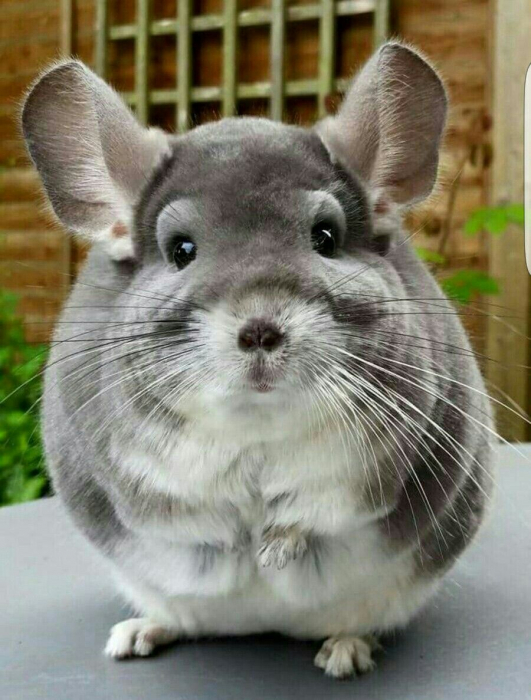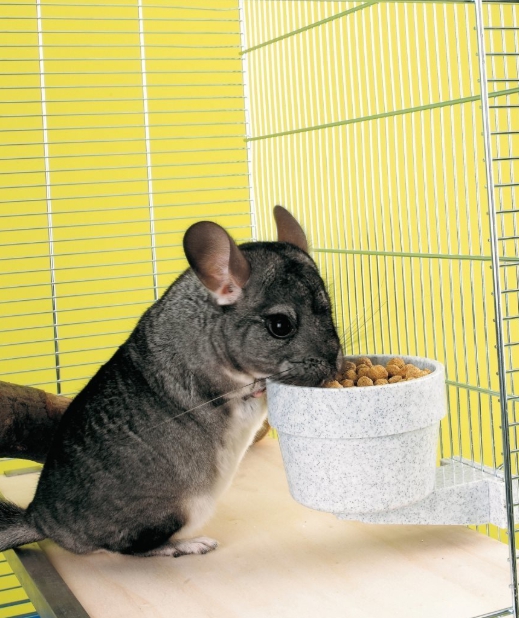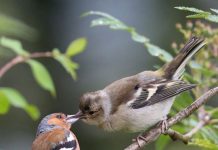If you decide to start a chinchilla, you are unlikely to be disappointed in your choice. These exotic rodents are beautiful and cute, watching them is a pleasure. However, despite the fact that these animals are close relatives of the usual hamsters, guinea pigs and decorative rats, the approach to them needs a slightly different approach. This article details the rules for the care and maintenance of chinchillas at home.
Material Content:
Brief Description of the View

Chinchilla (Chinchilla) - a rodent from the chinchilla family. There are several species of these animals: small long-tailed or coastal, short-tailed and large. In the wild, they live in South America, Argentina, Chile, Bolivia and Peru. For living choose rocky areas located at an altitude of 400-5000 meters above sea level.
This is a fairly large rodent. He has a well-fed, 22–38 cm long body covered with thick fur, and the weight ranges from 400-800 g. Females are usually larger than males. The female animal can reach a mass of 800 g, while males weigh on average 600-700 g.
The tail of an exotic animal is fluffy, slightly curved, 10 to 17 cm long. The head is large, rounded. The eyes are large, black, with vertical pupils. Vibrissa (mustache) is long, from 8 to 10 cm. The ears are rounded, protected by membranes. When the rodent takes sand baths, they close like valves, protecting the ear canals. In the oral cavity there are up to 20 teeth, most of them are molars. It is noteworthy that they grow throughout life.
The hind legs of the individual are twice as long as the front. This feature allows her to jump quite high. Moreover, there are 5 fingers on the forelimbs, and 4 on the hind limbs.
The natural color of the animal is dark gray.But after they were domesticated by Matthias Chapman in 1919 and their breeding began to gain popularity, many new colors appeared - white, coal, beige, sapphire and others. Today there are more than 200 of them.
The average life expectancy of chinchillas is 10-14 years, and sometimes up to 20 years. The animals reproduce their ability to reproduce up to 12-15 years.
Character, intelligence, behavior features
Chinchilla leads a nocturnal lifestyle and spends most of the day in a dream. It wakes up at about 19-20 hours, and the peak of activity occurs at 22 hours. At this time, the animal will move a lot, jump, run in the wheel, if it is in the cage.
One of the main character traits of an exotic animal is curiosity. He will not disregard any new object that appeared in his field of vision. In addition to studying and sniffing, in most cases he will not refuse and chew him. Therefore, the owners should carefully consider the choice of toys and decorative elements.
The animals are smart and trained. You can teach a chinchilla to the tray like a cat. Change the toilet every day. These rodents also have excellent memory, quickly remember household members and can react violently to their appearance. But only those animals who live alone are willing to make contact with people. And when the chinchilla has “companions”, she just needs to communicate with them. But if more than one individual lives in a cage, fights are not excluded. Despite the fact that in the wild these rodents lead a colonial lifestyle, they do not particularly need a company of relatives.
Communication with the owners and other animals is a rather complicated aspect. Taming a chinchilla is an almost impossible task, although there are exceptions. If you want to establish close contact with a new pet, do it from the first day, but act gradually. The first 2 weeks after the appearance of a new pet in your house, let him get comfortable, do not bother once again. And then start talking to him, addressing by name. When the animal gets used to you a little, open the cage and stretch out its palms - most likely, a curious rodent will rush to sniff them, and, possibly, will jump into your arms. Just do not try to catch a pet - he will be afraid of you.
The rodent will not notice other animals living in the house until they are interested in it. In this situation, the animal will fight back - it will begin to make crackling sounds, click its teeth, standing on its hind legs, and release a stream of urine. Maybe attacking - these rodents have long, sharp teeth. If there are other pets in your house, it is better to allocate a separate room for Shusha, inaccessible to them.
Attention! You should not start a chinchilla if there are small children in the house. The psyche of these animals is very fragile, they are subject to stress and do not like to be bothered. And if the rodent gets angry, he can bite the baby.
Chinchilla conditions

In order for your pet to be healthy and cheerful, you need to provide him with comfortable conditions. First of all - to choose the right cell. Remember that chinchillas are mobile and unusually jumping. Therefore, the home should be spacious, the more the better. The minimum cell size for one adult animal is 50 cm wide, 60 cm long and 70 cm high.
And also pay attention to the distance between the rods - it should not be large. Rodents have a special skeleton structure, which allows them to "leak out" even into small crevices. And if you plan to breed chinchillas, keep in mind that chinchillas will run away if there is at least 2 cm clearance between the rods.
Idea. Order or make your own showcase house for your pet. Such a dwelling will fit perfectly into any interior, dirt and debris will not fly around the closed walls, and chinchilla puppies will not be able to escape.
What should be in the cell:
- Horizontal shelves (preferably wooden), preferably a few.Rodents are very mobile, and your pet will be happy to jump from one surface to another.
- Running wheel. Chinchillas love not only jumping, but also running. The device is better to choose with a grid, and its size should be at least 28-30 cm in diameter.
- House. Exotic rodents need privacy from time to time. Buy your pet a suitable size home, preferably made of wood. Of course, the house will soon be nibbled, but such a gift will delight the shushu.
- Filler. You can use special granules that hold moisture, or sawdust, with the exception of conifers. Do not put newspapers or rags in the cage for the chinchilla. In the first case, the animal can be poisoned with bunny, which is contained in the paint, and in the second it will begin to eat threads, which will negatively affect digestion.
- Feeders made of metal or ceramic. Better if there are several. In one you will begin to put food, in another hay, to which chinchillas are great hunters, and in the third - any permitted treat. The containers should be fixed on an elevation, and not put on the bottom of the cage - so the contents will remain clean, debris and particles of filler will not get into it.
- Hay holder. It’s good if you can get this device and put the hay in it, and not in an ordinary feeding trough. So shusha will not be able to scatter dry grass throughout the cage.
- A drinking bowl with a spout. A mobile and restless chinchilla can splash water poured into a bowl, and drinking from such a device will not spill.
- Mineral stone. It is needed not only for the animal to sharpen its teeth, but also as a source of nutrients, primarily calcium.
- Toys It is not necessary to purchase expensive ones, walnut shells or wooden cubes (unpainted and without any other coating) will do. The pet will be happy to drag them from place to place and chew.
The house must be placed away from windows and batteries to avoid overheating or hypothermia of the animal. The temperature in the room should not be higher than 25 degrees, so if you live in an area where the summer is hot, you should take care of the split system.
Attention! Do not use a fan - the chinchilla may catch a cold. The same applies to humidifiers - increased humidity in these animals is only harmful.
Having settled the pet in the house and choosing a suitable place, one must not forget about maintaining cleanliness in the rodent's house and clean at least 1 time per week, or better twice.
Chinchilla diet at home
In the wild, the diet of these rodents consists of herbaceous plants, for the most part cereals and beans, moss, lichens, shrubs and tree bark. From animal foods they consume insects. But when kept in captivity, the nutrition of the chinchilla should be somewhat different.
The basis of the diet (at least 70% of the total) is a special granular feed and grain mix, consisting of wheat, oats, barley, pumpkin seeds, oatmeal, buckwheat, corn, flaxseeds and others.
In second place is hay. It must be present in the trough constantly, chinchillas love it very much. As treats, which can make up about 10% of the diet, it is allowed to give rodents twigs of willow, linden and apple tree, leaves of plantain, grapes, green tea, mother and match, cuffs, alfalfa. And also suitable dried carrots and apples, berries of hawthorn, viburnum, cranberries, mountain ash, wild strawberries, raspberries. Prepare several options for refreshments and alternate them.
Attention! Fruits, berries, branches and leaves can be given to rodents only in dried form. It is also forbidden to feed them with boiled, fried, canned and sweet foods (the body of the chinchillas is not adapted to process large amounts of glucose, there is a risk of developing diabetes).
It is necessary to give food to the pet once a day, 2 tbsp. l And also it is worth taking care of the water - it should be boiled or bottled. In no case do not pour tap water into the drinker.
Hair and Dental Care
Moisture is destructive for chinchilla wool, so you can’t bathe them in water. Thick, dense fur will dry for a long time, which threatens not only the common cold, but also skin problems, for example, dermatitis. In addition, water procedures are not necessary - these rodents do not emit an unpleasant odor, like many of their relatives (chinchillas do not have sebaceous and sweat glands), and the coat is so thick that parasites do not live in it. And to remove dust and dirt, you can use another method.
To clean the fur of an animal, offer him a sand bath. Pour volcanic sand (you can add chopped chalk and sulfur) into a special tray (and if it is not, then in a cut off five-liter bottle or other container of a suitable size) and place the animal there. He will flounder in it with pleasure, turning over on his back and side to side, like a spindle. Let it frolic for half an hour, and then comb out the fur with a comb to remove any remaining sand. Such swimming can be carried out up to 3 times a week.
Another important point is dental care. They grow throughout life, and if the rodent does not drain them, this threatens problems not only with the oral cavity, but also with digestion. And there are not many specialists capable of treating chinchilla diseases. If you live in a small town, most likely, there will be no one to help the deceased pet. Therefore, it is better to prevent troubles, and to get a shushhe mineral lickstone. So she will not only be able to grind her teeth, but also replenish the supply of a number of useful substances in the body.
As you can see, caring for a chinchilla is not so difficult. And the joy that this cute animal will bring to you is much more than troubles in its content.












